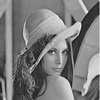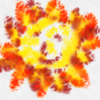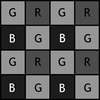 |
Mao, Jinzi, David Mould, Sriram Subramanian, "Background Subtraction for Real-time Tracking of a Tennis Ball", Computer Vision Theory and Applications (VISAPP), pp. 427-434, 2007. [PDF]
[Show Abstract]
[Show Bibtex]
In this paper we investigate real-time tracking of a tennis-ball using various image differencing techniques. First, we considered a simple background subtraction method with subsequent ball verification (BS). We then implemented two variants of our initial background subtraction method. The first is an image differencing technique that considers the difference in ball position between the current and previous frames along with a background model that uses a single Gaussian distribution for each pixel. The second is uses a mixture of Gaussians to accurately model the background image. Each of these three techniques constitutes a complete solution to the tennis ball tracking problem. In a detailed evaluation of the techniques in different lighting conditions we found that the mixture of Gaussians model produces the best quality tracking. Our contribution in this paper is the observation that simple background subtraction can outperform more sophisticated techniques on difficult problems, and we provide a detailed evaluation and comparison of the performance of our techniques, including a breakdown of the sources of error.
@inproceedings{Mao:2007:BSR,
author = {Mao, Jinzi and Mould, David and Subramanian, Sriram},
title = {Background Subtraction for Real-time Tracking of a Tennis Ball},
booktitle = {Computer Vision Theory and Applications (VISAPP)},
pages = {427--434},
year = 2007,
}
|
 |
O'Donovan, Peter, David Mould, "Felt-based Rendering", Proceedings of the 4th International Symposium on Non-photorealistic Animation and Rendering, pp. 55-62, 2006. [PDF]
[Show Abstract]
[Show Bibtex]
Felt is mankind's oldest and simplest textile, composed of a pressed mass of fibers. Images can be formed directly in the fabric by arranging the fibers to represent the image before pressure is applied. We describe a computational method for transforming input images into objects which look as if they were produced by a felting process. The synthesis method places three dimensional line segments one by one, analogous to individual fibers being placed. Individual layers of fibers are drawn according to image structure and a probabilistic framework. A fuzzy three dimensional felt object is created by compositing layers of fibers; rendering uses a deep shadow map for correct self-shadowing of the matted felt.
@inproceedings{O'Donovan:2006:FR:1124728.1124738,
author = {O'Donovan, Peter and Mould, David},
title = {Felt-based Rendering},
booktitle = {Proceedings of the 4th International Symposium on Non-photorealistic Animation and Rendering},
pages = {55--62},
year = 2006,
}
|
 |
Rangel-Kuoppa, Risto, David Mould, "Model Creation by Velocity Controlled Surface Deformation", Proceedings of the 6th International Conference on Computational Science - Volume Part II, pp. 318-325, 2006. [PDF]
[Show Abstract]
[Show Bibtex]
We present a scheme for the semiautomatic creation of 3D models through velocity-controlled surface deformations. Our surface representation consists of oriented points with volatile inter-neighboring point linkage. The surface is resampled in order to maintain an even distribution of points. Points created during resampling inherit their characteristics from their progenitors. Our surface representation and resampling behavior support detailed irregular surfaces with smooth transitions such as those of organic entities. Surface velocities are set by the combination of two types of operators, selection and velocity assignment, with operator application managed by a finite state machine. We demonstrate our scheme with the creation of some branched, fruit-like and mushroom-like models.
@inproceedings{Rangel-Kuoppa:2006:MCV:2170888.2170933,
author = {Rangel-Kuoppa, Risto and Mould, David},
title = {Model Creation by Velocity Controlled Surface Deformation},
booktitle = {Proceedings of the 6th International Conference on Computational Science - Volume Part II},
pages = {318--325},
year = 2006,
}
|
 |
Rudolf, Dave, David Mould, Eric Neufeld, "A bidirectional deposition model of wax crayons", Computer Graphics Forum, vol. 24, 2005. [PDF]
[Show Abstract]
[Show Bibtex]
We present a physically-inspired model of wax crayons, which synthesizes drawings from collections of user-specified strokes. Paper is represented by a height-field texture, and a crayon is modelled with a 2D mask that evolves as it interacts with the paper. The amount of wax deposition is computed based on the crayon contact profile, contact force, and friction. Previously deposited wax is smeared by crayon action, based on wax softness and contact information. Deposited wax can also be carved from the paper by the crayon and redeposited at another location. The distributed wax is rendered using a simplified Kubelka-Monk model, which approximates light transmission and scattering effects
@article{Rudolf:05:abidirectional,
author = {Rudolf, Dave and Mould, David and Neufeld, Eric},
title = {A bidirectional deposition model of wax crayons},
journal = {Computer Graphics Forum},
volume = {24},
year = 2005,
}
|
 |
Mould, David, "Image-guided Fracture", Proceedings of Graphics Interface, pp. 219-226, 2005. [PDF]
[Show Abstract]
[Show Bibtex]
We present an image filter that transforms an input line drawing into an image of a fractured surface, where the cracks echo the input drawing. The basis of our algorithm is the Voronoi diagram of a weighted graph, where the distance between nodes is path cost in the graph. Modifying the edge costs gives us control over the placement of region boundaries; we interpret region boundaries as cracks. The rendering of our crack maps into final images is accomplished either by image analogies or by modulation of an uncracked texture.
@inproceedings{Mould:2005:IF:1089508.1089545,
author = {Mould, David},
title = {Image-guided Fracture},
booktitle = {Proceedings of Graphics Interface},
pages = {219--226},
year = 2005,
}
|
 |
Mould, David, Michael C. Horsch, "A Hybrid Optimal-approximate Path Planning Algorithm", 18th Annual Canadian Conference on Electrical and Computer Engineering, 2005. [PDF]
[Show Abstract]
[Show Bibtex]
Path planning is the problem of finding the lowest-cost path between two endpoints in a weighted graph. An optimal algorithm, such as A*, is guaranteed to return the lowest-cost path. However, the computational expense of A* is high on a class of graphs called terrains, motivating the development of approximate algorithms such as HTAP (the hierarchical terrain representation for approximate paths). HTAP has computational cost linear in path length, rather than A*'s quadratic complexity, but does not guarantee the lowest cost path. However, HTAP's overhead means that very short paths are disproportionately costly to find. In this paper, we propose a hybrid algorithm which uses HTAP for long paths and A* for short paths. We empirically compare the hybrid algorithm to the HTAP algorithm on the basis of computational cost. The hybrid algorithm has a significant performance advantage over HTAP in the case of very short paths, and is the same as HTAP for long paths. We report results for a number of terrains, giving performance profiles with respect to path length
@inproceedings{Mould:2005:AHOA,
author = {Mould, David and Horsch, Michael C.},
title = {A Hybrid Optimal-approximate Path Planning Algorithm},
booktitle = {18th Annual Canadian Conference on Electrical and Computer Engineering},
year = 2005,
}
|
 |
Sookocheff, Kevin, David Mould, "One-click Lattice Extraction from Near-regular Texture", Proceedings of the 3rd International Conference on Computer Graphics and Interactive Techniques in Australasia and South East Asia, pp. 265-268, 2005. [PDF]
[Show Abstract]
[Show Bibtex]
We present a method for extracting a lattice from near-regular texture. Our method demands minimal user intervention, needing a single mouse click to select a typical texton. The algorithm follows a four-step approach. First, an estimate of texton size is obtained by considering the spacing of peaks in the auto-correlation of the texture. Second, a sample of the image around the user-selected texton is correlated with the image. Third, the resulting correlation surface is converted to a map of potential texton centres using non-maximal suppression. Finally, the maxima are formed into a graph by connecting potential texton centres. We have found the method robust in the face of significant changes in pixel intensity and geometric structure between textons.
@inproceedings{Sookocheff:2005:OLE:1101389.1101440,
author = {Sookocheff, Kevin and Mould, David},
title = {One-click Lattice Extraction from Near-regular Texture},
booktitle = {Proceedings of the 3rd International Conference on Computer Graphics and Interactive Techniques in Australasia and South East Asia},
pages = {265--268},
year = 2005,
}
|
 |
Eramian, Mark, David Mould, "Histogram Equalization Using Neighborhood Metrics", Proceedings of the 2Nd Canadian Conference on Computer and Robot Vision, pp. 397-404, 2005. [PDF]
[Show Abstract]
[Show Bibtex]
We present a refinement of histogram equalization which uses both global and local information to remap the image greylevels. Local image properties, which we generally call neighborhood metrics, are used to subdivide histogram bins that would be otherwise indivisible using classical histogram equalization (HE). Choice of the metric influences how the bins are subdivided, affording the opportunity for additional contrast enhancement. We present experimental results for two specific neighborhood metrics and compare the results to classical histogram equalization and local histogram equalization (LHE). We find that our methods can provide an improvement in contrast enhancement versus HE, while avoiding undesirable over-enhancement that can occur with LHE and other methods. Moreover, the improvement over HE is achieved with only a small increase in computation time.
@inproceedings{Eramian:2005:HEU:1068505.1068830,
author = {Eramian, Mark and Mould, David},
title = {Histogram Equalization Using Neighborhood Metrics},
booktitle = {Proceedings of the 2Nd Canadian Conference on Computer and Robot Vision},
pages = {397--404},
year = 2005,
}
|
 |
Mould, David, Michael C. Horsch, "An Hierarchical Terrain Representation for Approximately Shortest Paths", Pacific Rim Conference on Artificial Intelligence, pp. 104-113, 2004. [PDF]
[Show Abstract]
[Show Bibtex]
We propose a fast algorithm for on-line path search in grid-like undirected planar graphs with real edge costs (aka terrains). Our algorithm depends on an off-line analysis of the graph, requiring poly-logarithmic time and space. The off-line preprocessing constructs a hierarchical representation which allows detection of features specific to the terrain. While our algorithm is not guaranteed in general to find an optimal path, we demonstrate empirically that it is very fast, and that the difference from optimal is almost always small.
@inproceedings{Mould:04:AHTR,
author = {Mould, David and Horsch, Michael C.},
title = {An Hierarchical Terrain Representation for Approximately Shortest Paths},
booktitle = {Pacific Rim Conference on Artificial Intelligence},
pages = {104--113},
year = 2004,
}
|
 |
Mould, David, Carl Gutwin, "The Effects of Feedback on Targeting with Multiple Moving Targets", Proceedings of the 2004 Graphics Interface Conference, pp. 25-32, 2004. [PDF]
[Show Abstract]
[Show Bibtex]
A number of task settings involve selection of objects from dynamic visual environments with multiple moving targets. Target selection is difficult in these settings because objects move, because there are a number of distracter objects for any targeting action, and because objects can occlude the target. Target feedback has been suggested as a way to assist targeting in visual environments. We carried out an experiment to test the effects of visual target feedback. We found that targeting does become more difficult as the number and speed of objects increases, and that feedback can improve error rates. When feedback was provided on all objects in the space, performance improved significantly over no feedback. Target-only feedback, however, was not significantly better than no feedback. This is a valuable result because all-object feedback is in most cases the only implementation option - since it is usually not possible to pre-determine the user's target among the set of objects.
@inproceedings{Mould:2004:EFT:1006058.1006062,
author = {Mould, David and Gutwin, Carl},
title = {The Effects of Feedback on Targeting with Multiple Moving Targets},
booktitle = {Proceedings of the 2004 Graphics Interface Conference},
pages = {25--32},
year = 2004,
}
|
 |
Mould, David, "A Stained Glass Image Filter", Proceedings of the 14th Eurographics Workshop on Rendering, pp. 20-25, 2003. [PDF]
[Show Abstract]
[Show Bibtex]
Medieval stained glass windows are a stylized artform that has not previously been thoroughly treated in the computer graphics literature. In this paper, we present an automated method for transforming an arbitrary image into a stained-glass version of that image. The key issues in designing a stained glass window are the tile boundaries and tile colors. We use erosion and dilation operators to manipulate and smooth an initial region segmentation tiling; we choose tile colors from the palette of heraldic tinctures; and finally, we render a displacement-mapped plane to obtain our final image.
@inproceedings{Mould:2003:SGI:882404.882407,
author = {Mould, David},
title = {A Stained Glass Image Filter},
booktitle = {Proceedings of the 14th Eurographics Workshop on Rendering},
pages = {20--25},
year = 2003,
}
|
 |
Rudolf, Dave, David Mould, Eric Neufeld, "Simulating Wax Crayons", Proceedings of the 11th Pacific Conference on Computer Graphics and Applications, pp. 163-, 2003. [PDF]
[Show Abstract]
[Show Bibtex]
We present a physically-inspired model of wax crayons, which synthesizes drawings from collections of user-specified strokes. Paper is represented by a height-field texture, and a crayon is modelled with a 2D mask that evolves as it interacts with the paper. The amount of wax deposition is computed based on the crayon contact profile, contact force, and friction. Previously deposited wax is smeared by crayon action, based on wax softness and contact information. The distributed wax is rendered using a simplified Kubelka-Monk model, which approximates light transmittance and scattering effects.
@inproceedings{Rudolf:2003:SWC:946250.946956,
author = {Rudolf, Dave and Mould, David and Neufeld, Eric},
title = {Simulating Wax Crayons},
booktitle = {Proceedings of the 11th Pacific Conference on Computer Graphics and Applications},
pages = {163--},
year = 2003,
}
|
 |
Neufeld, Eric, Haruna Popoola, David Callele, David Mould, "Mixed Initiative Interactive Edge Detection", Proceedings of Graphics Interface, 2003. [PDF]
[Show Abstract]
[Show Bibtex]
Interactive edge detection is used in both graphics art tools and in tools for building anatomical models from serially sectioned images. To build models, contours are traced and later triangulated. Contour tracing is time-consuming because of the fidelity and quantity of points needed, and expensive because of the background training required of individuals who do the tracing. Here we report extensions to interactive edge detection that reduce errors and effort. Our key contribution is a simple feedback interface called the leash, currently implemented as an extension to Intelligent Scissors, that lets the human user ‘lead ’ the edge detection algorithm along a contour, but also helps the user to anticipate errors and provide immediate corrective feedback.
@inproceedings{Neufeld_mixedinitiative,
author = {Neufeld, Eric and Popoola, Haruna and Callele, David and Mould, David},
title = {Mixed Initiative Interactive Edge Detection},
booktitle = {Proceedings of Graphics Interface},
year = 2003,
}
|
 |
Rangel-Kuoppa, Risto, Carlos Aviles-Cruz, David Mould, "Distributed 3D Rendering System in a Multi-agent Platform", Proceedings of the 4th Mexican International Conference on Computer Science, pp. 168-, 2003. [PDF]
[Show Abstract]
[Show Bibtex]
In this work, we propose a 3D rendering system thatdistributes rendering tasks across a multi-agent platform.The new approach is based on a multi-agent platform,where the goal is to create a virtual 3D environment. Themain task is the rendering of individual objects. Each 3Dobject must be rendered in a remote unit; the resultingrendering is sent through the network to a 3Dvisualization process which generates the visualization ofthe whole 3D environment. The object movement andremote communication requirements have beenimplemented using a multi-agent system platform. Thedistributed system is implemented in Windows O.S., usingDirectX graphical libraries and JAVA programming. Themulti-agent platform used is JADE. The computerconnection is a LAN at 100 MBS in a star topology.
@inproceedings{Rangel-Kuoppa:2003:DRS:942794.943175,
author = {Rangel-Kuoppa, Risto and Aviles-Cruz, Carlos and Mould, David},
title = {Distributed 3D Rendering System in a Multi-agent Platform},
booktitle = {Proceedings of the 4th Mexican International Conference on Computer Science},
pages = {168--},
year = 2003,
}
|
 |
Neufeld, Eric, David Callele, David Mould, Sonje Kristtorn, Raymond Rabu, "A Contribution to the Theory and Practice of Cognitive Prostheses", Proceedings of the 3rd International Conference on Smart Graphics, pp. 241-250, 2003. [PDF]
[Show Abstract]
[Show Bibtex]
Ford and Hayes suggest that rather than think of AI as independent technologies, we think of AI as a human/machine partnership, where the AI "amplifies, rather than replaces human intellectual ability". We used their perspective to build a smart mixed initiative edge detection tool and believe this approach will be particularly useful in building other effective intelligent graphical tools.
@inproceedings{Neufeld:2003:CTP:1757492.1757522,
author = {Neufeld, Eric and Callele, David and Mould, David and Kristtorn, Sonje and Rabu, Raymond},
title = {A Contribution to the Theory and Practice of Cognitive Prostheses},
booktitle = {Proceedings of the 3rd International Conference on Smart Graphics},
pages = {241--250},
year = 2003,
}
|
 |
Grant, Kevin, David Mould, Michael Horsch, Eric Neufeld, "Enhancing Demosaicking Algorithms using Loopy Propagation", Sixth International Conference on Computer Graphics and Artificial Intelligence, 2003. [PDF]
[Show Abstract]
[Show Bibtex]
Consumer-level digital cameras observe a single value at each pixel. The remaining two channels of a three-channel image are reconstructed through a process called demosaicking. This paper describes a methodology for enhancing current demosaicking methods. Using an iterative relaxation approach from probabilistic AIliterature, our empirical results show that we can improve the results of the standard algorithms using monitored successive application of those algorithms. We apply the new technique to several algorithms: hue-based interpolation, gradient-based interpolation, and adaptive colour plan interpolation; and we show a significant improvement in mean-squared error over both RGB and CIE colour spaces using each of these algorithms.
@inproceedings{Grant:2003:EDA,
author = {Grant, Kevin and Mould, David and Horsch, Michael and Neufeld, Eric},
title = {Enhancing Demosaicking Algorithms using Loopy Propagation},
booktitle = {Sixth International Conference on Computer Graphics and Artificial Intelligence},
year = 2003,
}
|
















